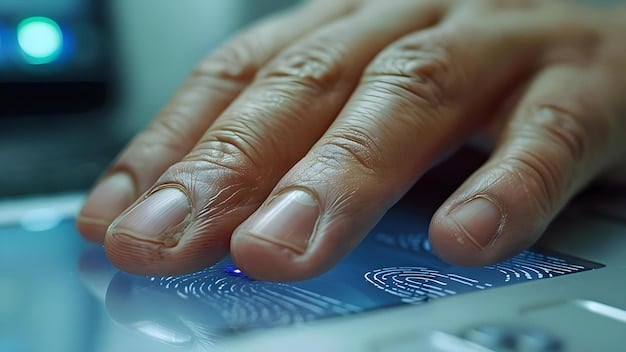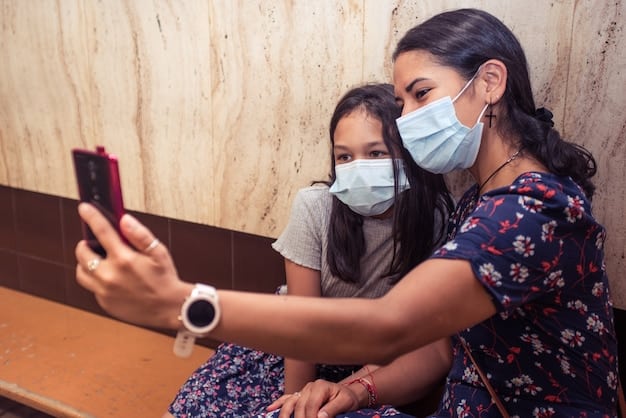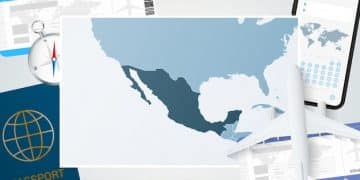Biometrics Appointment for Mexican Immigrants in US: Practical Solutions

Navigating the biometrics appointment for Mexican immigrants in the US requires meticulous preparation, including gathering essential documents, understanding the process, and addressing potential issues to ensure a smooth and successful experience critical for immigration proceedings.
For many Mexican immigrants pursuing legal residency or other immigration benefits in the United States, the biometrics appointment is a pivotal step. This seemingly straightforward process, which involves collecting fingerprints, photographs, and signatures, is crucial for background checks and identity verification. Understanding how to prepare effectively for your Practical Solutions: How to Prepare for Your Biometrics Appointment as a Mexican Immigrant in the US can significantly reduce stress and prevent unnecessary delays in your immigration journey.
Understanding the Biometrics Appointment: What to Expect
The biometrics appointment, often referred to as an “ASC appointment” (Application Support Center), is a mandatory part of many USCIS (U.S. Citizenship and Immigration Services) applications. It’s not an interview but a data collection session. USCIS uses this information to conduct security checks and verify your identity. For Mexican immigrants, this step is particularly vital, as it contributes to the thorough vetting process required for various immigration statuses, including green cards, work permits, and naturalization.
During the appointment, several key pieces of information are gathered. Your fingerprints are taken digitally, typically all ten fingers. A digital photograph will be taken for identification purposes, and you will also provide a digital signature. This data is then cross-referenced with various government databases, including the FBI’s criminal databases, to ensure national security and prevent fraud. Understanding that this is a procedural step rather than an evaluative one can help alleviate anxiety.
The entire process is designed to be efficient, usually taking less than 30 minutes once you are called. However, wait times at the Application Support Centers can vary significantly based on the location and time of day. It is always advisable to arrive early to account for potential delays. The notice you receive from USCIS will specify the exact date, time, and location of your appointment, along with a list of required documents.
The purpose of biometrics in immigration
Biometrics serve multiple critical functions within the immigration framework. Primarily, they are used for identity verification and background checks. This helps USCIS confirm that the applicant is who they claim to be and that they do not pose a security risk. It also helps detect any previous immigration violations or criminal history that might impact the application’s outcome. For Mexican immigrants, whose applications often involve complex histories, the accuracy of this data is paramount.
- Security Clearance: Enables federal agencies to conduct comprehensive background checks against national and international databases.
- Identity Verification: Confirms the applicant’s identity, preventing fraud and ensuring the integrity of the immigration system.
- Application Processing: The collected data is an essential component for processing various immigration benefits, from visas to green cards.
Beyond security, biometrics also aid in processing efficiency. By having a unique identifier, USCIS can streamline the management of applicant files and reduce the chances of errors or identity mix-ups. This systematic approach ensures that each application is robustly vetted, contributing to the overall security and efficacy of the U.S. immigration system.
Essential Documents and Paperwork for Your Appointment
Preparation is key, and gathering the correct documents is perhaps the most crucial “practical solution” for your biometrics appointment. The most important document is your official USCIS appointment notice, Form I-797C, Notice of Action. This notice contains a barcode that the ASC staff will scan to access your case. Without this notice, you will not be able to proceed with your appointment. It is essential to print this notice and bring it with you.
In addition to the appointment notice, you must bring a valid form of identification. For most Mexican immigrants, this will be your passport or a government-issued photo ID. Ensure that the ID is current and matches the name on your USCIS application exactly. Discrepancies can cause significant delays or even cancellation of your appointment. If your name has changed, bring proof of the name change, such as a marriage certificate or a court order.
Although not always explicitly required, it is also a good practice to bring a copy of the immigration application for which you are submitting biometrics. For example, if you applied for an adjustment of status, bring a copy of your Form I-485. This can be helpful if there are any questions regarding your application or if the ASC staff needs to cross-reference information. Having extra documentation is always better than not having enough.
What to typically bring with you
Beyond the primary documents, a few other items can ensure a smooth experience. These might not be mandatory but are highly recommended to avoid any last-minute issues or discomfort.
- USCIS Appointment Notice (Form I-797C): This is non-negotiable.
- Valid Photo Identification: Passport, national ID, or state-issued driver’s license.
- Copy of Your Application: The specific USCIS form you filed (e.g., I-485, I-765).
- Pen: For any last-minute forms or signatures.
- List of Questions: If you have any specific concerns about your next steps, although ASC staff generally cannot provide case-specific advice beyond the biometrics collection.
Ensure all documents are originals, or certified copies if originals are not available. Do not bring unnecessary items that could cause security concerns, such as large bags or weapons, as these are typically not allowed inside federal buildings. Keep your documents organized in a folder for easy access, and double-check everything the night before.
Navigating the Application Support Center (ASC) Process
Understanding the flow of your visit to the Application Support Center (ASC) can significantly ease your mind. Upon arrival, you will first pass through a security checkpoint, similar to airport security. Be prepared to remove any metal objects, and your belongings may be scanned. It’s advisable to leave unnecessary items at home to expedite this process. Once cleared, you will proceed to the reception area.
At the reception desk, you will hand over your USCIS appointment notice (Form I-797C) and your valid photo identification. The staff will scan your barcode and verify your identity. This is when they confirm your appointment and check your details against their system. Any discrepancies at this stage, such as a mismatch between the name on your ID and the name on your notice, will need to be resolved before you can proceed. Ensure all your documents clearly present the same information.
After your information is verified, you will be directed to a waiting area. Wait times can vary, so bring a book or something to occupy yourself, but avoid using electronic devices excessively, especially if you need to be attentive to your name being called. When it’s your turn, an ASC officer will call your name and direct you to a workstation where your biometrics will be collected.

What happens at the workstation?
At the workstation, the officer will scan the barcode on your appointment notice again. They will then guide you through the process of capturing your fingerprints, photograph, and digital signature. The fingerprinting process typically involves placing individual fingers and then full hands on a digital scanner. Make sure your hands are clean and dry for accurate prints.
- Fingerprinting: All ten fingers and thumbs will be digitally scanned.
- Photograph: A digital photo will be taken. Ensure your face is clearly visible, with no hats or large accessories.
- Digital Signature: You will sign your name on a digital pad.
The officer will verify the quality of the collected data. If any prints are unclear or the photo is not up to standard, they may retake them. Once all biometrics are successfully captured, the officer will tell you that the process is complete. You will not receive any documents back, as the data is sent electronically to USCIS. There will be no interview or discussion about your case at this appointment; it is purely for data collection. You are then free to leave the ASC building.
Common Pitfalls and How to Avoid Them
Even with thorough preparation, some common issues can arise during a biometrics appointment. Being aware of these pitfalls can help Mexican immigrants avoid unnecessary stress and delays. One of the most frequent problems is arriving late or missing the appointment altogether. USCIS appointments are scheduled rigorously, and missing your slot without prior rescheduling can lead to significant setbacks in your immigration process, potentially requiring new filings or causing lengthy delays. Always aim to arrive at least 15-30 minutes early.
Another common pitfall is bringing incorrect or expired identification. As mentioned, your ID must be valid and accurately reflect your current legal name. If your ID has expired, or if there’s a discrepancy in your name due to marriage, divorce, or other legal changes, you must bring supporting legal documentation. Without proper identification, the ASC staff cannot verify your identity, and your appointment will likely be rescheduled, prolonging your legal journey.
Finally, a less obvious but still problematic issue can be not being mentally or physically prepared. While not an interview, the stress of an immigration process can be taxing. Ensure you are well-rested and feel well on the day of your appointment. If you have a temporary condition affecting your fingerprints, such as cuts or injuries, it’s advisable to consult with USCIS or your attorney beforehand to understand the implications and possible accommodations.
Tips for a smooth and successful visit
Proactive measures can mitigate most potential issues and ensure your biometrics appointment goes as smoothly as possible. These practical tips are especially valuable for Mexican immigrants who may be navigating the U.S. legal system for the first time or with limited English proficiency.
- Confirm Appointment Details: Double-check the date, time, and location on your Form I-797C well in advance.
- Organize Documents: Keep your essential documents (appointment notice, valid ID) easily accessible in a folder.
- Dress Comfortably: Wear comfortable, yet appropriate, clothing. Consider that you will be photographed.
- Practice Your Signature: If you are required to provide a digital signature, practice signing clearly.
- Check for Service Changes: Before heading out, check the USCIS website for any service alerts or closures related to your specific ASC.
- Stay Calm: The ASC staff are there to collect data, not evaluate your case. Remain composed and cooperative.
If you anticipate any issues, such as needing language assistance or having special accommodations, contact USCIS customer service or your immigration attorney prior to your appointment. While interpreters are generally not provided at ASCs, some locations may have bilingual staff or access to language services. Being prepared for these contingencies can save a lot of time and anxiety.
What Happens After the Biometrics Appointment?
Once you complete your biometrics appointment, the collected data is electronically transmitted to USCIS and relevant federal agencies. This is not the end of your immigration process, but rather a crucial intermediate step. The fingerprint and background check results are typically valid for 15 months from the date of collection. USCIS uses this period to process your application and make a decision.
You will not receive immediate feedback on the results of your background check. Instead, USCIS will proceed with the adjudication of your immigration application based on the received biometrics and all other submitted documents. The nature of the next step depends entirely on the specific application you filed. For instance, if you are applying for adjustment of status (green card), your next step might be an interview, or a decision may be made based solely on the submitted evidence.
It is important to remember that your biometrics appointment is just one piece of the immigration puzzle. Continue to monitor your mail for any further notices from USCIS. You can also check the status of your case online using the receipt number provided on your Form I-797C. This online tool offers a convenient way to track progress, but it’s crucial not to rely solely on it for critical updates; physical mail notices are still the official form of communication.
Next steps in the immigration process
The path forward after your biometrics appointment varies widely depending on your specific immigration application. However, understanding the general progression can help you anticipate future actions.
- Case Adjudication: USCIS reviews your entire application, including biometrics results and all supporting documents.
- Request for Evidence (RFE): USCIS may send an RFE if they need additional information or documents to make a decision. Respond promptly if you receive one.
- Interview: Many applications, such as adjustment of status or naturalization, require an interview at a USCIS field office. You will receive a separate appointment notice for this.
- Decision: Ultimately, USCIS will send you a notice of their decision – approval, denial, or a request for additional action.
During this waiting period, it’s essential to keep your contact information updated with USCIS. If you move, file a change of address immediately using Form AR-11. Failure to do so can result in missed notices, potentially leading to significant delays or even the denial of your application. Patience is often required during this phase, as processing times can vary considerably based on the type of application and the workload of USCIS.
Special Considerations for Mexican Immigrants
Mexican immigrants, like all foreign nationals, must adhere to USCIS procedures, but certain cultural, linguistic, and practical aspects may require additional consideration. Language barriers, for instance, can sometimes complicate understanding appointment notices or communicating with ASC staff. While ASCs are not set up to provide interpretation services, bringing a trusted bilingual friend or family member for moral support and clarity can be helpful, though they cannot accompany you into the biometrics collection area itself.
For many Mexican immigrants, the journey to the U.S. and the immigration process can involve personal histories that affect documentation. Ensuring all identifying documents – such as birth certificates, marriage licenses, and previous immigration records – are consistent and translated if necessary into English by certified translators, is vital. Discrepancies between official records, particularly names or dates of birth, can flag issues during background checks and fingerprint matching. Addressing these concerns proactively, ideally with legal counsel, before the biometrics appointment is a proactive step.
Another point of consideration is familiarity with federal buildings and procedures. Some immigrants may feel apprehension or unfamiliarity with government institutions. Being well-informed about what to expect, as outlined in this guide, can alleviate much of this stress. Prior knowledge of the security checks, the brief nature of the appointment, and the absence of an interview can help manage expectations and create a calmer experience.
Addressing documentation and other unique challenges
Specific documentation challenges are not uncommon for Mexican immigrants. For example, if a birth certificate has inaccuracies or if an individual used varying names in different contexts, these issues must be reconciled before or during the immigration application process. An attorney specializing in Mexican immigration cases can provide invaluable guidance in such situations, helping to prepare affidavits or gather supplementary evidence to support identity and legal name.
- Name Consistency: Ensure all documents (ID, application, foreign records) use the exact same name. Address discrepancies with legal counsel.
- Translations: Any foreign language documents required for your application must be translated into English by a certified translator.
- Legal Representation: Consider consulting an immigration attorney, especially if your case has complexities or unique circumstances.
- Emotional Support: The process can be stressful. Lean on your support network for emotional well-being.
Finally, understand that the U.S. immigration system is constantly evolving. Policies and procedures can change, so staying informed through reliable sources like the official USCIS website or trusted immigration attorneys is crucial. For Mexican immigrants, staying connected with community legal aid services or non-profit organizations that offer immigration assistance can also provide up-to-date information and support, ensuring they are well-prepared for every stage of their journey, including the biometrics appointment.
The Importance of Legal Counsel and Support Systems
While the biometrics appointment itself is a procedural step, the broader immigration journey for Mexican immigrants can be complex and fraught with legal intricacies. Engaging with qualified legal counsel, even for what seems like minor steps, can provide invaluable peace of mind and prevent costly mistakes. An experienced immigration attorney can help you understand the nuances of your application, ensure all documents are correctly filed, and advise on any potential issues that might arise during the biometrics or subsequent stages.
For many, particularly those navigating the U.S. immigration system for the first time, an attorney acts as a crucial guide. They can explain the specific requirements for your visa type or immigration benefit, help gather the appropriate supporting evidence, and prepare you for what to expect at each stage. Attorneys are also trained to handle unforeseen complications, such as requests for evidence, interview preparation, or responses to denials, significantly increasing the likelihood of a successful outcome.
Beyond legal counsel, having a strong support system is equally vital. This includes family members, community organizations, and non-profit groups that offer aid to immigrants. These networks can provide emotional support, share personal experiences, and even offer practical assistance such as transportation to appointments or help with translation. The immigration process can be lengthy and emotionally draining, and having a reliable support system can help mitigate the psychological toll.

Finding reputable legal and community resources
Identifying legitimate and trustworthy sources for legal assistance and community support is paramount to avoid fraudulent practices. Unfortunately, some individuals or organizations may prey on immigrants’ vulnerabilities. Always verify credentials and seek recommendations from trusted sources before engaging with any legal professional or service provider.
- Accredited Attorneys: Ensure any attorney is licensed and in good standing with their state bar association. Search for attorneys specializing in immigration law.
- Non-Profit Organizations: Many non-profit groups offer free or low-cost legal services and support for immigrants. Organizations like Catholic Charities, CLINIC, or local community centers often provide excellent resources.
- USCIS Website: The official USCIS website is a primary source for reliable information, forms, and updates on immigration policies.
- Community Support Groups: Look for local groups or online forums where other Mexican immigrants share experiences and tips, but always cross-reference information with official sources.
Remember that investing in proper legal guidance and leveraging community support systems can save you significant time, money, and stress in the long run. These resources are designed to empower immigrants and help them navigate the often-complex U.S. immigration landscape efficiently and effectively. For Mexican immigrants in the U.S., understanding and utilizing these practical solutions for their biometrics appointment as part of a larger, well-supported journey is key to achieving their immigration goals.
| Key Point | Brief Description |
|---|---|
| 📋 Document Checklist | Crucial to bring USCIS appointment notice (I-797C) and valid photo ID; also recommended to bring application copies. |
| 📍 ASC Process | Involves security check, document verification, and a quick collection of fingerprints, photo, and digital signature. |
| ⚠️ Avoid Pitfalls | Timeliness, valid ID, and preparation are vital to prevent delays or rescheduling. |
| ⚖️ Seek Support | Legal counsel and community support systems offer crucial guidance for complex cases and general well-being. |
Frequently Asked Questions
▼
A biometrics appointment, also known as an ASC appointment, is where USCIS collects your fingerprints, photograph, and digital signature. These are used for identity verification and comprehensive background checks by various federal agencies to ensure national security and prevent fraud in immigration applications.
▼
You absolutely must bring your official USCIS appointment notice (Form I-797C) and a valid government-issued photo identification, such as a passport or state ID. It’s also advisable to bring a copy of the immigration application for which you are submitting biometrics.
▼
The actual collection of biometrics usually takes less than 30 minutes. However, you should factor in wait times at the Application Support Center, which can vary. Arriving 15-30 minutes early is recommended to ensure you are processed efficiently.
▼
Yes, you can reschedule your biometrics appointment if absolutely necessary. You must make a request to USCIS to reschedule, usually by following the instructions on your Form I-797C notice or calling USCIS customer service. Rescheduling can cause delays in your application processing.
▼
After your biometrics are collected, the data is sent to USCIS for background checks. You will not receive immediate results. Your immigration application will then proceed, and the next steps (e.g., interview, Request for Evidence, decision) depend on your specific case type. USCIS will notify you via mail.
Conclusion
Preparing for your biometrics appointment as a Mexican immigrant in the U.S. is a critical yet manageable step in your immigration journey. By meticulously gathering all required documents, understanding the procedural nature of the visit, and recognizing common pitfalls, you can ensure a smooth and efficient experience. Leveraging legal counsel and robust community support systems can further empower you to navigate the complexities of the immigration process, ultimately contributing to a more confident and successful path toward your immigration goals.





